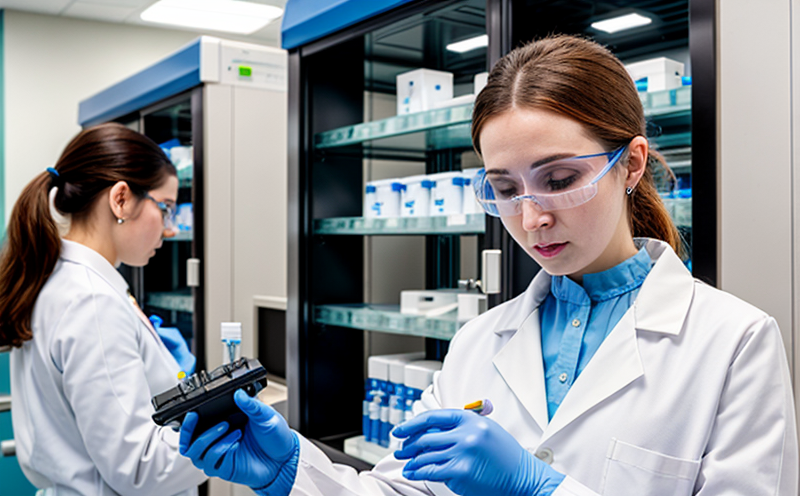Toxicokinetic Bioanalysis Testing
In the pharmaceutical sector, understanding how a drug is absorbed, distributed, metabolized, and excreted (ADME) within the body is crucial for ensuring both efficacy and safety. Toxicokinetics specifically focuses on the time course of drug concentrations in biological fluids, tissues, or organs, providing insights into potential toxic effects at various stages.
Toxicokinetic bioanalysis testing plays a pivotal role in pharmaceutical development by identifying critical pharmacokinetic parameters such as absorption (AUC), distribution (Vd), metabolism (t1/2), and elimination rates. This knowledge is vital for optimizing drug dosing regimens, predicting potential side effects, and ensuring compliance with regulatory standards.
The testing process involves the collection of biological samples from test subjects or in vitro models at specific time points after administration of the substance. These specimens are then analyzed using advanced analytical techniques to measure concentrations over time. The choice of sample type (e.g., plasma, urine) depends on the drug’s pharmacokinetic characteristics and its route of administration.
Instrumentation used in this testing includes high-performance liquid chromatography (HPLC), liquid chromatography-mass spectrometry (LC-MS/MS), and gas chromatography-mass spectrometry (GC-MS). These methods ensure accurate quantification of drug metabolites and parent compounds, allowing for precise determination of the kinetic parameters.
Preparation of biological samples is a critical step to ensure reliable results. This includes extraction using techniques like liquid–liquid partitioning or solid-phase extraction, followed by derivatization if necessary before analysis. Quality control measures such as spike recovery and matrix effects are implemented to validate the robustness of analytical methods.
The interpretation of toxicokinetic data is complex and requires a multidisciplinary approach involving pharmacologists, biochemists, and statisticians. Pharmacokinetic models are often developed using non-linear mixed-effects modeling (NONMEM) software to analyze the collected data. These models help predict drug behavior under various conditions, aiding in the development of safer and more effective therapeutics.
- Quality Control Measures: Regular calibration of instruments, use of certified reference materials, and implementation of standard operating procedures are essential to maintain high-quality data.
- Data Validation: Utilization of robust statistical methods to validate the accuracy and precision of the analytical results.
In conclusion, toxicokinetic bioanalysis testing is a cornerstone in pharmaceutical development. It provides indispensable information for optimizing drug design, ensuring regulatory compliance, and enhancing patient safety. By leveraging this comprehensive approach, laboratories can contribute significantly to advancing the field of medicine.
Benefits
The implementation of toxicokinetic bioanalysis testing offers numerous advantages in the pharmaceutical sector:
- Enhanced Drug Safety: By identifying potential toxic effects early in development, companies can minimize risks associated with adverse drug reactions.
- Informed Dosing Regimens: Accurate determination of pharmacokinetic parameters allows for personalized medicine approaches, improving treatment outcomes.
- Regulatory Compliance: Adherence to international standards such as FDA, EMA, and ICH ensures that drugs meet stringent quality and safety requirements.
- Risk Assessment: Early detection of toxicokinetic issues reduces the likelihood of costly failures during clinical trials.
These benefits underscore the importance of comprehensive toxicokinetic bioanalysis in ensuring the development of safe and effective pharmaceuticals.
Quality and Reliability Assurance
To ensure the reliability and accuracy of toxicokinetic bioanalysis testing, several quality assurance measures are implemented:
- Instrument Calibration: Regular calibration of instruments to maintain precision and accuracy.
- Spike Recovery Studies: Testing the recovery rates of spiked samples to ensure reliable quantification.
- Matrix Effects: Evaluating how matrix components influence analytical results.
- Data Validation: Utilization of robust statistical methods to validate analytical results.
These measures are critical for maintaining the integrity and consistency of test data, ensuring that the results can be trusted by regulatory bodies and stakeholders alike.
International Acceptance and Recognition
Toxicokinetic bioanalysis testing is widely recognized and accepted across international standards. Compliance with these standards ensures global acceptance of pharmaceutical products:
- FDA (United States): The Food and Drug Administration mandates rigorous pharmacokinetic studies to ensure drug safety.
- EMA (European Union): The European Medicines Agency requires comprehensive toxicokinetic data as part of the approval process.
- ICH Guidelines: International Conference on Harmonisation guidelines provide a harmonized framework for pharmacokinetic testing worldwide.
Adherence to these standards not only ensures regulatory compliance but also facilitates smoother market access in multiple jurisdictions.





